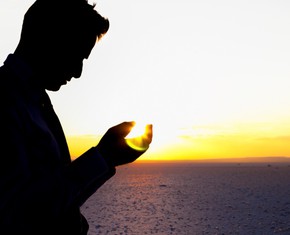The views expressed in our content reflect individual perspectives and do not represent the authoritative views of the Baha'i Faith.
As a graduate student, I had a series of vivid, hyper-real dreams—so I decided to see if I could determine what they meant.
How did I do it? I read voraciously about dreams, trying to understand their mechanism and their meaning. I studied the symbols that occur in so many archetypal dreams. I learned about the Tibetan Buddhist practice called dream Yoga—becoming aware of dreams while still asleep. The ancient Hindus, I later found out, had a similar method of understanding their dreams, called Yoga nidra, which involves developing a heightened state of consciousness in that “twilight zone” between waking and sleeping.
In Yoga nidra, you completely relax your body and gradually learn to become systematically and increasingly aware of the inner dream world. You gradually turn off your outer senses, calm and still your mind, relax deeply and try to reach a state the Buddhists call samadhi, or total awareness of the moment—an inner condition known as one-pointedness. (In Buddhism, samadhi is the last of the eight elements of the Noble Eightfold Path.) Once you begin to master the skills of Yoga nidra, you do eventually fall into a deep sleep, but you increasingly retain some of your waking awareness for at least part of that time. You learn to enter your dreams, and your subconscious, in a conscious way.
I didn’t just ponder the Eastern wisdom, though—I looked at the Western scientific and psychological findings, too. Of all the Western insights I discovered, the great psychologist Carl Jung seemed to make the most sense, with his extensive study and work on dream interpretation and the personal unconscious. I tried to further deepen my understanding of dreams by reading the Baha’i writings on the subject, which fascinated me and still do to this day.
Then, after all this, I tried to learn the skill called lucid dreaming.
Aristotle wrote about lucid dreaming, saying “when one is asleep, there is something in consciousness which declares that what then presents itself is but a dream.” The great Roman philosopher and physician Galen used his own lucid dreams as a form of self-therapy. But the phrase “lucid dreaming” was first coined about a hundred years ago by the Dutch psychiatrist Frederik van Eeden, who said that human beings can experience a unique state of consciousness between waking and dreaming, just by learning to control their awareness during sleep. Sounds a lot like Yoga nidra, doesn’t it?
Here’s how lucid dreaming works: first, start by keeping a dream journal, trying to recall your dreams every morning by writing them down. This part of the process will gradually familiarize you with your own particular internal dreamscape, and will begin to make you more aware of the content of your subconscious in the bargain.
 Second, practice the basic skills of Yoga nidra by lying completely still as you fall asleep, clearing your mind and attempting to extend your waking consciousness into the world of your dreams.
Second, practice the basic skills of Yoga nidra by lying completely still as you fall asleep, clearing your mind and attempting to extend your waking consciousness into the world of your dreams.
Third, concentrate on your intention to consciously become aware of what you’re dreaming—not only when you wake up, but before you fall asleep and as you dream.
Fourth, try to envision yourself becoming more and more lucid—more conscious, more aware and more present—in your dreams.
During the course of all this, I never became any sort of adept or expert—which takes a diligent, consistent practice for many years—but I did learn, over time, to extend that wonderful period between sleep and waking. In that state, I realized how to teach my conscious mind to reach a little further into my subconscious and better understand my dreams.
If you practice these learned skills every night as you go to sleep, you’ll become much more conscious of your own personal dream world, and you’ll begin to sharpen your awareness of what your subconscious tries to tell you. Then, if you read a few good books on dream interpretation, you’ll discover a wealth of wisdom.
Beyond those valuable personal insights, the Baha’i teachings tell us, the world of dreams has a great deal more to convey to us about the human soul and its mysteries:
Now there are many wisdoms to ponder in the dream… First, what is this world, where without eye and ear and hand and tongue a man puts all of these to use? Second, how is it that in the outer world thou seest today the effect of a dream, when thou didst vision it in the world of sleep some ten years past? Consider the difference between these two worlds and the mysteries which they conceal, that thou mayest attain to divine confirmations and heavenly discoveries and enter the regions of holiness.
God, the Exalted, hath placed these signs in men, to the end that philosophers may not deny the mysteries of the life beyond nor belittle that which hath been promised them. – Baha’u’llah, The Seven Valleys, pp. 32-33.
Isn’t that fascinating? When Baha’u’llah wrote that dreams and their signs of our subconscious exist “to the end that philosophers may not deny the mysteries of the life beyond,” it suggests that dreams exist to tell us, and prove to us, that we have souls.
You May Also Like
Comments

















beautiful post